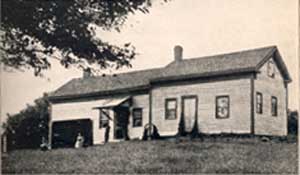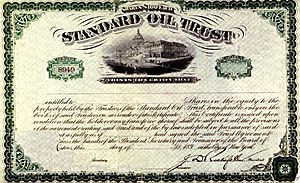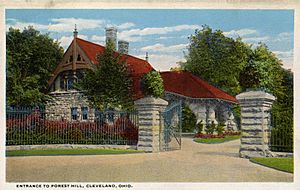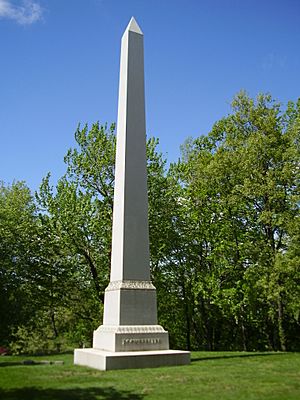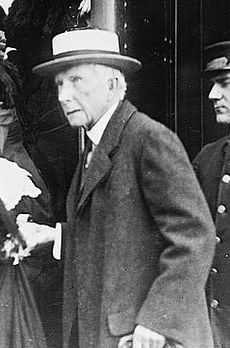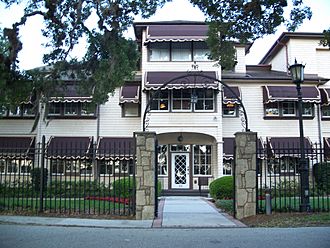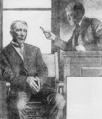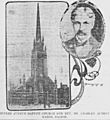John D. Rockefeller facts for kids
Quick facts for kids
John D. Rockefeller
|
|
|---|---|
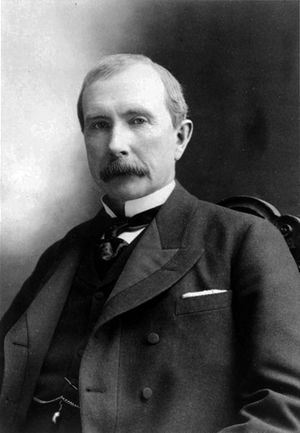
John D. Rockefeller in 1885
|
|
| Born |
John Davison Rockefeller
July 8, 1839 Richford, New York, U.S.
|
| Died | May 23, 1937 (aged 97) The Casements
Ormond Beach, Florida, U.S. |
| Burial place | Lake View Cemetery, Cleveland, Ohio, U.S. 41°30′40″N 81°35′28″W / 41.511°N 81.591°W |
| Occupation | Oil industry business magnate and philanthropist |
| Known for | Founding and leading the Standard Oil Company
Founding the University of Chicago, Rockefeller University, Central Philippine University, General Education Board and Rockefeller Foundation |
| Net worth | US$478 billion (in 2022 dollars; inflation-adjusted) in 1913, according to Forbes (1.5% to 2% of the United States economy; or approximately 1/65th to 1/50th of its GDP) |
| Political party | Republican |
| Spouse(s) | Laura Celestia Spelman (m. 1864–1915; her death) |
| Children | Elizabeth, Alice, Alta, Edith, and John Jr. |
| Parent(s) |
|
| Relatives | Rockefeller family |
John Davison Rockefeller (born July 8, 1839 – died May 23, 1937) was a very successful American businessman. He made a huge fortune in the oil industry. He was also a philanthropist, which means he gave away a lot of his money to help others.
Contents
Early Life
John D. Rockefeller was born in Richford, New York. He was the second of six children. His father, William A. Rockefeller Sr., was a traveling salesman. He often sold fake medicines and was not around much.
John's mother, Eliza Davison, was a very religious and careful person. She taught her children to work hard and save money. She often said, "Willful waste makes woeful want," meaning if you waste things on purpose, you will regret it later.
John helped with chores and earned money by raising turkeys and selling potatoes. He learned early on to make good deals. His mother had a big influence on him. He later said, "From the beginning, I was trained to work, to save, and to give."
His family moved several times when he was young. They lived in Moravia and Owego, New York. In 1853, they moved to Strongsville, Ohio. John went to Cleveland's Central High School. He also took a ten-week business course to learn bookkeeping.
Even though his father was often absent, John was a serious and hardworking boy. People described him as quiet, earnest, and religious. He was good at debating and loved music. When he was young, John said he wanted to make $100,000 and live to be 100 years old.
Building an Oil Empire
In September 1855, at age sixteen, John Rockefeller got his first job. He worked as an assistant bookkeeper for a small company in Cleveland.
In 1858, he started his own business. His company, Clark & Rockefeller, invested in an oil refinery in 1862. An oil refinery is a factory that turns crude oil into useful products like kerosene.
In 1865, Rockefeller bought out his partner's share in another refinery. He paid $72,500 for a bigger share and started a new company called Rockefeller & Andrews. He said this day "determined my career."
He was in a good position to succeed after the American Civil War. The country was growing fast, with new railroads and a need for oil. He borrowed money, reinvested his profits, and quickly adapted to changes in the market.
In 1870, John D. Rockefeller, his brother William, Henry M. Flagler, and others formed the Standard Oil Company. John D. Rockefeller became its president.
Standard Oil grew very large and eventually controlled most of the oil production in America. By making oil products cheaper, almost everyone could afford them.
Rockefeller stopped being actively involved in the business in 1895. He had also owned large iron mines and ships. He sold these to U.S. Steel.
By 1901, he was worth about $900 million. He was believed to be the richest man in the world at that time. If you adjust his wealth for inflation and compare it to the size of the U.S. economy today, he would be far richer than any billionaire now.
In 1911, the Supreme Court of the United States decided that Standard Oil was a monopoly. A monopoly is when one company controls almost all of an industry. The court ordered Standard Oil to be broken up into about 37 new companies.
Family and Beliefs
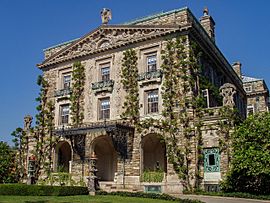
John D. Rockefeller was a member of the Baptist church. He married Laura C. Spelman, a teacher, on September 8, 1864, in Cleveland. They had five children:
- Elizabeth "Bessie" Rockefeller (1866–1906)
- Alice Rockefeller (1869–1870)
- Alta Rockefeller (1871–1962)
- Edith Rockefeller (1872–1932)
- John Davison Rockefeller Jr. (1874–1960)
His youngest child, John D. Rockefeller Jr., inherited much of his father's fortune.
Some of Rockefeller's grandchildren and great-grandchildren became famous. His grandson, Nelson Rockefeller, was Vice President of the United States. Another grandson, Winthrop Rockefeller, was the Governor of Arkansas. His great-grandson, Jay Rockefeller, was a U.S. Senator.
In 1910, Rockefeller announced he was retiring from managing his businesses. He wanted to spend all his time on his charitable work.
Later Years and Legacy
In his 50s, Rockefeller had some health problems, including stress and hair loss. By 1901, he started wearing toupées. His health improved as he worked less.
John D. Rockefeller died on May 23, 1937. He was almost 98 years old. He passed away at his home in Ormond Beach, Florida. He was buried in Lake View Cemetery in Cleveland. When he died, his wealth was estimated to be over $5 billion.
When he was 86, Rockefeller wrote a short poem about his life: I was early taught to work as well as play, My life has been one long, happy holiday; Full of work and full of play— I dropped the worry on the way— And God was good to me everyday.
A Walt Disney character named John D. Rockerduck, who is popular in Europe, is named after him.
Giving Back: Rockefeller's Philanthropy
Rockefeller started giving to charity when he was just 16. He gave six percent of his earnings. By the time he was twenty, he gave more than ten percent of his income. Much of his early giving went to his church. As he became richer, he gave more and more. He focused on education, public health, science, and the arts.
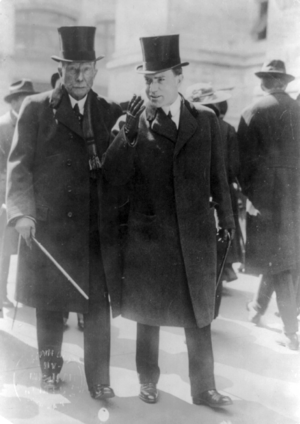
In 1884, Rockefeller gave a lot of money to the Atlanta Baptist Female Seminary. This school was for African-American women and is now known as Spelman College. His wife, Laura Spelman Rockefeller, cared deeply about civil rights and equality for women. They both supported the school because it matched their beliefs.
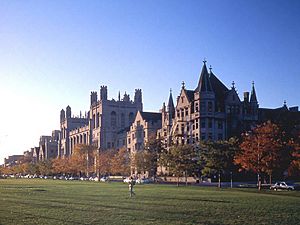

Rockefeller gave $80 million to the University of Chicago. This helped turn a small Baptist college into a world-class university by 1900. He called it "the best investment I ever made." He also helped found Central Philippine University in Asia in 1905.
In 1903, he created the General Education Board. This group helped promote education across the country. It was especially active in supporting schools for Black students in the Southern United States. Rockefeller also gave money to famous universities like Yale, Harvard, and Columbia.
Rockefeller became a major supporter of medical science. In 1901, he founded the Rockefeller Institute for Medical Research in New York City. This institute, now called Rockefeller University, has been connected to many Nobel Prize winners. In 1909, he started the Rockefeller Sanitary Commission. This organization helped get rid of hookworm disease, which was a big problem in the American South.
He created the Rockefeller Foundation in 1913. He gave $182 million to this foundation. It focused on public health, medical training, and the arts. It helped build the Peking Union Medical College in China. The foundation also helped with World War I relief efforts.
Rockefeller's fourth main charity was the Laura Spelman Rockefeller Memorial Foundation, started in 1918. It supported social studies and later joined the Rockefeller Foundation. In total, Rockefeller donated about $530 million.
In his later life, Rockefeller became known for giving dimes to adults and nickels to children. He even gave dimes to wealthy friends as a playful gesture. He also supported the 18th Amendment, which banned alcohol in the United States.
His Winter Home in Florida
Henry Flagler, who helped Rockefeller start Standard Oil, bought the Ormond Hotel in Florida in 1890. Rockefeller first stayed at this hotel in 1914. He liked the area so much that he bought an estate nearby called The Casements. This became his winter home for the rest of his life. Today, The Casements is a cultural center and an important historical building in Ormond Beach.
Images for kids
-
Rockefeller around 1902. By then, his mustache had fallen off due to alopecia.
-
Judge Kenesaw Mountain Landis with John D. Rockefeller during the Standard Oil case on July 6, 1907
-
John D. Rockefeller's painting by John Singer Sargent in 1917
See also
 In Spanish: John D. Rockefeller para niños
In Spanish: John D. Rockefeller para niños


